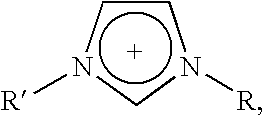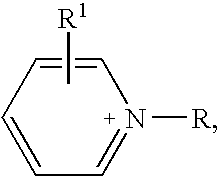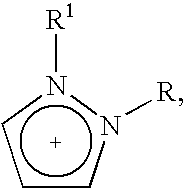Halogen-free ionic liquids
a technology of ionic liquids and halogen-free ions, which is applied in the field of ionic liquids, can solve the problems of large cost, considerable corrosion, and use of these anions
- Summary
- Abstract
- Description
- Claims
- Application Information
AI Technical Summary
Benefits of technology
Problems solved by technology
Method used
Image
Examples
synthetic example 1
(pyridinium) (Me(O—CH2—CH2)2O—SO3)
[0186]To a solution of 10.48 g (87.22 mmol) of diethylene glycol monomethyl ether, 13.9 g of pyridine-SO3 complex (87.22 mmol) is added in small portions at 0° C. The reaction mixture is further stirred at 25° C. for 18 hours. The product is obtained in quantitative yield in the form of a yellowish liquid with a surprisingly low viscosity. The melting point of the substance is below 20° C.
[0187]NMR:
[0188]1H-NMR (300 MHz, CDCl3): δ=9.03 (d, 2H, CH—(CH—CH)2—N), 8.71 (m, 1H, CH—(CH—CH)2—N), 8.20 (m, 2H, CH—(CH—CH)2—N), 4.25 (tr, 2H, O3—S—O—CH2—CH2—O—CH2—CH2—O—CH3), 3.69 (tr, 2H, O3—S—O—CH2—CH2—O—CH2—CH2—O—CH3), 3.66 (tr, 2H, O3—S—O—CH2—CH2—O—CH2—CH2—O—CH3), 3.54 (tr, 2H, O3—S—O—CH2—CH2—O—CH2—CH2—O—CH3), 3.32 (s, 3H, O3—S—O—CH2—CH2—O—CH2—CH2—O—CH3) ppm.
[0189]13C-NMR (75 MHz, CDCl3): δ=147.1, 142.0, 127.8, 71.7, 70.1, 69.5, 66.8, 58.7 ppm.
[0190]A general synthetic scheme for this example is depicted in Scheme 1.
synthetic example 2
(pyridinium) (Me(O—CH2—CH2)3—O—SO3)
[0191]To a solution of 20.87 g (127.1 mmol) of triethylene glycol monomethyl ether, 20.23 g of pyridine-SO3 complex (127.1 mmol) is added in small portions at 0° C. The reaction mixture is further stirred at 25° C. for 18 hours. The product is obtained in quantitative yield in the form of an almost colorless liquid. The melting point of the substance is below 20° C. A general synthetic scheme for this example is depicted in Scheme 1.
[0192]NMR:
[0193]1H-NMR (300 MHz, CDCl3): δ=9.02 (d, 2H, CH—(CH—CH)2—N), 8.71 (m, 1H, CH—(CH—CH)2—N), 8.24 (m, 2H, CH—(CH—CH)2—N), 4.25 (tr, 2H, O3—S—O—CH2—CH2—O—CH2—CH2—O—CH2—CH2—O—CH3), 3.77 (tr, 2H, O3—S—O—CH2—CH2—O—CH2—CH2—O—CH2—CH2—O—CH3), 3.65 (m, 6H, O3—S—O—CH2—CH2—O—CH2—CH2—O—CH2—CH2—O—CH3), 3.53 (tr, 2H, O3—S—O—CH2—CH2—O—CH2—CH2—O—CH2—CH2—O—CH3), 3.32 (s, 3H, O3—S—O—CH2—CH2—O—CH2—CH2—O—CH2—CH2—O—CH3) ppm.
[0194]13C-NMR (75 MHz, CDCl3): δ=147.1, 142.0, 127.8, 71.6, 70.3-70.1, 69.6, 66.8, 58.8 ppm.
synthetic example 3
(1-butyl-3-methylimidazolium) (Me(O—CH2—CH2)2—O—SO3)
Method 1:
[0195]In a sublimation apparatus, 21.88 g of (pyridinium) (Me(O—CH2—CH2)2—O—SO3) (78.33 mmol) (prepared by the method as described in Synthetic Example 1) and 13.68 g of (1-butyl-3-methylimidazolium)Cl (78.33 mmol) are heated at 80° C. under vacuum. Under these conditions, (pyridinium)Cl sublimes from the reaction mixture to precipitate on the cooling surfaces of the sublimation apparatus in the form of white needles. After 8 h, the (pyridinium)Cl is completely removed from the reaction mixture, and the liquid yellowish product with a surprisingly low viscosity can be removed from the sublimation apparatus in quantitative yield. The melting point of the substance is below 20° C. A general synthetic scheme for this example is depicted in Scheme 2.
Method 2:
[0196]37.13 g of diethylene glycol monomethyl ether (308.99 mmol) and 30.0 g of sulfamic acid (308.99 mmol) are added to a 250 ml Schlenk flask and heated at 85° C. with s...
PUM
| Property | Measurement | Unit |
|---|---|---|
| melting point | aaaaa | aaaaa |
| viscosity | aaaaa | aaaaa |
| melting point | aaaaa | aaaaa |
Abstract
Description
Claims
Application Information
 Login to View More
Login to View More - R&D
- Intellectual Property
- Life Sciences
- Materials
- Tech Scout
- Unparalleled Data Quality
- Higher Quality Content
- 60% Fewer Hallucinations
Browse by: Latest US Patents, China's latest patents, Technical Efficacy Thesaurus, Application Domain, Technology Topic, Popular Technical Reports.
© 2025 PatSnap. All rights reserved.Legal|Privacy policy|Modern Slavery Act Transparency Statement|Sitemap|About US| Contact US: help@patsnap.com



